Intel's Architecture Day 2018: The Future of Core, Intel GPUs, 10nm, and Hybrid x86
by Dr. Ian Cutress on December 12, 2018 9:00 AM EST- Posted in
- CPUs
- Memory
- Intel
- GPUs
- DRAM
- Architecture
- Microarchitecture
- Xe
Changing How Chips are Made: 3D Packaging with FOVEROS
Anyone who has followed any amount of chip design in semiconductors should well-aware that most of the CPUs and SoCs in production today are based on monolithic dies – single pieces of silicon the have all what is needed inside, before being placed on a package and into a system. While rarer, there are multi-chip packages, were multiple chips go in one package with a shared connection. Beyond this we have seen interposers or embedded bridges designed to bring different chips together with high-speed interconnects. Now Intel is ready to bring 3D stacking into the mass market.
One of the biggest challenges in modern chip design is minimizing die area. A small die decreases costs – typically power too – and can make it easier to implement in a system. When it comes down to extracting performance however, we are at the limits of scale – one of the downsides of big monolithic dies, or even multi-chip packages, is that memory is too far away. Intel today is now ready to talk about its Foveros technology, which involves active interposers in small form factors to bring differentiated technologies together.
Foveros: It’s Greek for Awesome, Apparently
The way Raja introduced this technology started with discussing process technologies. Intel has for many years/decades been focused on high performance process nodes, trying to extract as much as possible from its high-performance cores. Alongside this, Intel also runs an IO optimized process node on a similar cadence but more suitable for PCH or SoC-type functions.
The 126x and 127x are the internal numbering systems for Intel’s process node technologies, although they don’t differentiate between BKM updates for the "+" node variants it turns out. But the point here is that Intel already knows that it needs certain process optimizations in place depending on the type of transistors, performance, and power needed. Going forward, Intel is going to be expanding its node base out so it can cover more power and performance points.
So for this example, Raja pulled out the current set of process technologies for 2019. For a manufacturing process, compute has the 1274 process on 10nm, IO has the 1273 process (14nm), while this new special Foveros technology is under P1222. Alongside the manufacturing, Intel will be working on optimizations focusing on the compute aspects of the manufacturing node. There will also be a set of developments for future node technologies, and the final column shows that Intel has path-finding research to look into future technologies and determine what capabilities will be possible on future designs. This sounds pretty much what a company like Intel should be doing, so no argument from me so far. The goal here is that each type of transistor use case can be different, and there isn’t a one-size fits all approach.
One way to assist with this is through chiplets and packaging. By picking the best transistor for the job in each case, whether it is CPU, GPU, IO, FPGA, RF, or anything else, with the correct packaging, it can be put together to get the best optimizations available.
So here’s where Foveros fits in. Foveros is Intel’s new active interposer technology designed as a step above its own EMIB designs for small form-factor implementations, or those with extreme memory bandwidth requirements. For these designs the power per bit of data transferred is super low, however the packaging technology has to deal with the decreased bump pitch, the increased bump density, and also the chip stacking technology. Intel says that Foveros is ready for prime time, and they can produce it at scale.
So this Foveros ‘3D’ packaging just sounds like a silicon interposer, such as what we’ve seen on AMD’s Fiji or NVIDIA’s high-end datacenter GPUs. However Intel is going above what those products are doing by actually making the interposer part of the design. The interposer contains the through-silicon vias and traces required to bring power and data to the chips on top, but the interposer also carries the PCH or IO of the platform. It is, in effect, a fully working PCH, but with vias to allow chips to be connected on top.
The first iteration of this technology is less complicated that the slide above, just using a set of CPU cores attached to the PCH below, but the idea is that a large interposer can have select functions on it and those can be removed from the chips above to save space. This also lets Intel use the different transistor types in different chips – the example we were given uses an interposer built on the 22FFL process node, with a 10nm set of CPUs on the top die. Above this, DRAM is provided in a POP package. Sounds cool, right?
In actual fact, Intel had a Foveros chip or two working in the demo area. These, Intel explained, were hybrid x86 designs that combined a single big Core with four smaller Atom cores on the same 10nm piece of silicon. I’m sure I’ve heard about big.Little before, but I was shocked that Intel is actually going to do it! We managed to take a photo of the block diagram, which Intel removed from its slide deck before sending it out to the press after the presentations. All details on the next page.


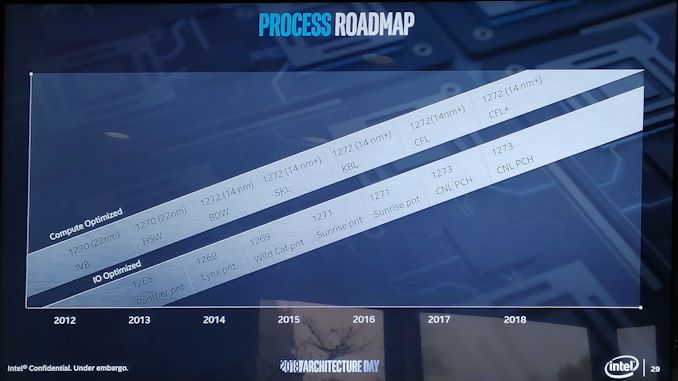
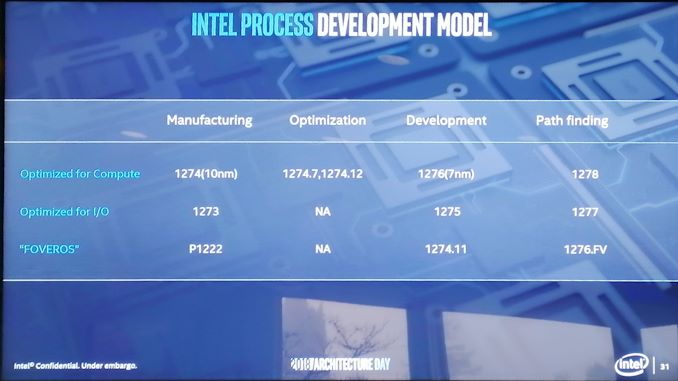
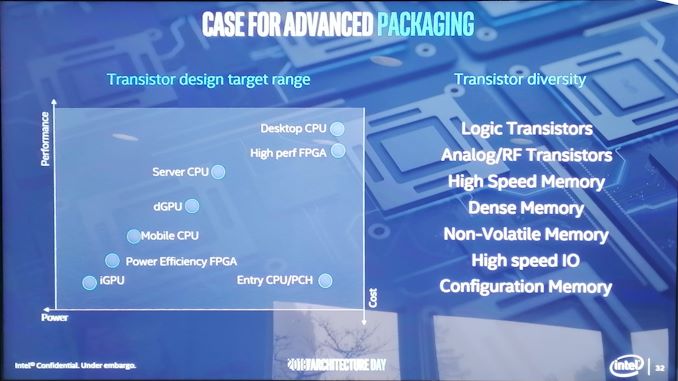
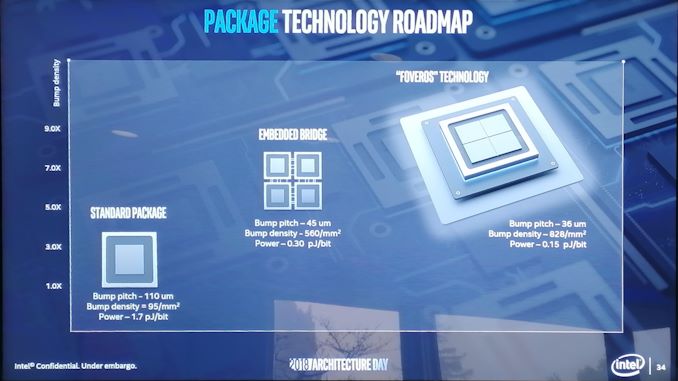
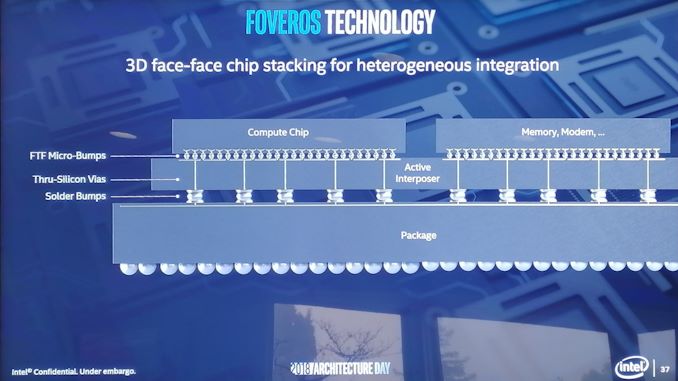
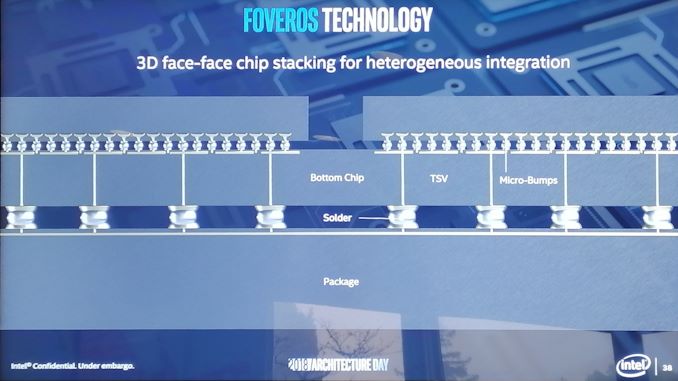








148 Comments
View All Comments
prisonerX - Wednesday, December 12, 2018 - link
And you're a special brand of pathetic. Congrats.Don't worry though, one day you'll hit puberty and things will improve.
LogitechFan - Wednesday, December 12, 2018 - link
Oh yes, amdturds are THE breed of stupid to behold...drunkenmaster - Wednesday, December 12, 2018 - link
Would that be Marvell's chip from 3 years ago that suddenly people are talking about... which is just a chip on an interposer with an HBM chip. HBM which AMD co-developed, had prototype APU packages using it in 2011 and launched Fury X with HBM on an interposer 3 years ago.Right, but AMD didn't pioneer it, because Marvell made a dramatically less complex switch using the same concept at the same time AMD did, but you know, AMD co-developed the memory, they worked with the packaging plants for years to be able to mass produce interposer packaged products and Fury X was the reason HBM went into full production in the first place.... but sure, AMD definitely didn't pioneer this latest move.
ajc9988 - Wednesday, December 12, 2018 - link
http://www.eecg.toronto.edu/~enright/micro14-inter... http://www.eecg.toronto.edu/~enright/Kannan_MICRO4... https://youtu.be/G3kGSbWFig4 https://seal.ece.ucsb.edu/sites/seal.ece.ucsb.edu/... https://www.youtube.com/watch?v=d3RVwLa3EmM&t=...qap - Wednesday, December 12, 2018 - link
Well ... yeah. Intel had multi-chip CPUs almost 15 years ago (look for Pentium D). And it was mocked by AMD and its fans.I thought that the mocking intel did last month was just to remind AMD, what they said then and I found it hilarious. But maybe not. People don't change and it's completely plausible, that it was said by someone, who does't know the history.
Topweasel - Wednesday, December 12, 2018 - link
Never Mocked by AMD. They just made sure to point out that their 2 cores with the X2 and quad with the Phenom where "real" multicore chips. It mattered more back then because Intel's boards had FSB's instead of direct connections and the separate chips had to talk through the FSB and chipset northbridge to talk to each other. Also AMD hadn't been rambling on thier glue tech for years (with no product yet on market using it (Kaby-G isn't actual EMIB)) when they made their statements.AMD promoted their products said they are better because they were real. There is a negative connotation with that. But that is different then calling out your competitor for using "glue".
29a - Wednesday, December 12, 2018 - link
"Well ... yeah. Intel had multi-chip CPUs almost 15 years ago (look for Pentium D). And it was mocked by AMD and its fans."I think pretty much everyone mocked anything P4 related, you have to admit it was pretty bad.
FreckledTrout - Wednesday, December 12, 2018 - link
What's P4? To flush it down the toilet.tshoobs - Wednesday, December 12, 2018 - link
Never heard that one before! So true, the P4 was such an embarrassment.JlHADJOE - Wednesday, December 12, 2018 - link
lol this takes me right back to the days of the P4, and the awesome "x is good... for me to POOP on!" meme